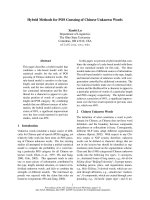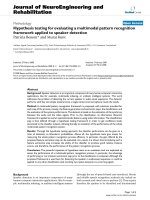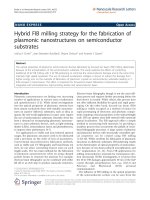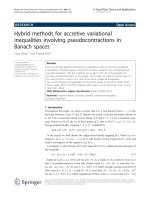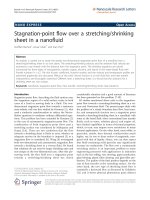Báo cáo hóa học: " Hybrid methods for accretive variational inequalities involving pseudocontractions in Banach spaces" pot
Bạn đang xem bản rút gọn của tài liệu. Xem và tải ngay bản đầy đủ của tài liệu tại đây (261.51 KB, 9 trang )
RESEARC H Open Access
Hybrid methods for accretive variational
inequalities involving pseudocontractions in
Banach spaces
Yaqin Wang
1,2*
and Rudong Chen
3
* Correspondence:
1
Department of Mathematics,
Shaoxing University, Shaoxing
312000, China
Full list of author information is
available at the end of the article
Abstract
We use strongly pseudocontractions to regularize a class of accretive variational
inequalities in Banach spaces, whe re the accretive operators are complements of
pseudocontractions and the solutions are sought in the set of fixed points of
another pseudocontraction. In this paper, we consider an implicit scheme that can
be used to find a solution of a class of accretive variational inequalities.
Our results improve and generalize some recent results of Yao et al. (Fixed Point
Theory Appl, doi:10.1155/2011/180534, 2011) and Lu et al. (Nonlinear Anal, 71(3-4),
1032-1041, 2009).
2000 Mathematics subject classification 47H05; 47H09; 65J15
Keywords: hybrid method, accretive operator, variational inequality,
pseudocontraction
1. Introduction
Throughout this paper, we always assume that E is a real Banach space, 〈·,·〉 is the
dual pair between E and E*, and 2
E
denotes the family of all the nonempty subsets of
E. Let C be a non empty closed convex subset of E and T : C ® E be a nonlinear map-
ping. Denote by Fix(T)thesetoffixedpointsofT,thatis,Fix(T)={x Î C : Tx = x}.
The generalized duality mapping J : E ® 2
E*
is defined by
J
(
x
)
= {f
∗
∈ E
∗
: x, f
∗
= ||x||, ||f
∗
|| = ||x||}, ∀x ∈ E
.
In the sequel, we shal l denote the single-valued duality mapping by j.When{x
n
}isa
sequence in E, x
n
® x (x
n
⇀ x, x
n
⇁ x) will denote strong (respectively, weak and
weak*) convergence of the sequence {x
n
}tox.
A mapping T with domain D(T ) and range R(T)inE is called pseudocontractive if
the inequality
||x − y|| ≤ ||x − y + t
((
I − T
)
x −
(
I − T
)
y
)
|
|
(1:1)
holds for each x, y Î D(T)andforallt>0. As a result of [ 1], it follows from (1.1)
that T is pseudocontractive if and only if there exists j (x-y) Î J(x-y) such that 〈Tx -
Ty, j(x-y)〉 ≤ ||x-y||
2
for any x, y Î D(T). T is called strongly pseudocontractive if
there exist j(x-y) Î J (x-y)andb Î (0, 1) such that 〈Tx - Ty, j(x-y)〉 ≤ b ||x-y||
2
for any x, y Î D(T). T is called Lipschitzian if there exists L ≥ 0suchthat||Tx - Ty||
Wang and Chen Fixed Point Theory and Applications 2011, 2011:63
/>© 2011 Wang and Chen; licensee Springer. This is an Open Access article distributed under the te rms of the Creative Commons
Attribution License ( which permits unrestricted use, distribution, and reproduction in
any medium, provid ed the original work is properly cited.
≤ L||x-y||, ∀ x, y Î D(T). If L = 1, then T is called nonexpansive, and it is called con-
traction if L Î [0, 1).
Let E = H be a Hilbert space with inner product 〈·,·〉. Recall that T : C ® H is
called monotone if 〈Tx - Ty, x-y〉 ≥ 0, ∀ x, y Î C. A variational inequality problem,
denoted by VI(T, C), is to find a point x* with the property
x
∗
∈ C, such that
Tx
∗
, x − x
∗
≥ 0, ∀x ∈ C
.
If the mapping T is a monotone operator, then we say that VI(T, C) is monotone.
In [2], Lu et al. considered the following type of monotone variational inequality pro-
blem in Hilbert spaces(denoted by VI(1.2))
find x
∗
∈ Fix
(
T
)
such that
(
I − S
)
x
∗
, x − x
∗
≥0, ∀x ∈ Fix
(
T
),
(1:2)
where T, S : C ® C arenonexpansivemappingsandFix(T) ≠ ∅.LetW denote the
set of solutions of the VI(1.2).
Very recently, Yao et al. [3] considered VI(1.2) in Hilbert spaces when T, S : C ® C
are pseudocontractions.
In this paper, we consider the following variational inequality problem in Banach
spaces (denoted by VI(1.3))
find x
∗
∈ Fix
(
T
)
such that
(
I − S
)
x
∗
, j
(
x − x
∗
)
≥0, ∀x ∈ Fix
(
T
)
,
(1:3)
where T, S : C ® C are pseudocontr actions. Let Ω denote the set of solutions of the
VI(1.3) and assume that Ω is nonempty. Since I-Sis accretive, then we say VI(1.3) is
an accretive variational inequality.
For solving the VI(T, C), hybrid methods were studied by Yamada [4] where he
assumed that T is Lipschitzian and strongly monotone. However, his methods do not
apply to the VI(1.2) since the mapping I-Sfails, in general, to be strongly monotone,
though it is Lipschitzian. In fact the VI(1.2) is, in general, ill-posed, and thus regulari-
zation is needed. Let T, S : C ® C be nonexpansive and f : C ® C be contractive. In
2006, Moudafi and Mainge [5] studied the VI(1.2) by regularizing the mapping tS +(1
-t)T and defined {x
s,t
} as follows:
x
s,t
= sf
(
x
s,t
)
+
(
1 − s
)
[tSx
s,t
+
(
1 − t
)
Tx
s,t
], s, t ∈
(
0, 1
).
(1:4)
Since Moudafi and Mainge’s regularization depends on t, the convergence of the
scheme (1.4) is more complicated. So Lu et al. [2] defined {x
s,t
} as follows by regula riz-
ing the mapping S:
x
s,t
= s [tf
(
x
s,t
)
+
(
1 − t
)
Sx
s,t
]+
(
1 − s
)
Tx
s,t
, s, t ∈
(
0, 1
).
(1:5)
Note that Lu et al.’s regularization does no long er depen d on t. And their result for
the regularization (1.5) is under dramatically less restrictive conditions than Moudafi
and Mainge’s [5].
Very recently, Yao et al. [3] extended Lu et al.’s result t o a gen eral case, i.e., in the
scheme (1.5), S, T are extended to Lipschitz pseudocontractive and f is extend ed to
strongly pseudocontractive. But in [3], after careful discussion, we observe that a conti-
nuity condition on f is necessary. So, in this paper, we modify it.
Motivated and inspired by the above work, in this paper, we use strongly pseudocon-
trations to regularize the ill-posed accretive VI(1.3), and analyze the convergence of
Wang and Chen Fixed Point Theory and Applications 2011, 2011:63
/>Page 2 of 9
the scheme (1.5). The results we obtained improve and extend the corresponding
results in [2,3].
2 Preliminaries
If Banach space E admits sequentially continuous duality mapping J from weak topol-
ogy from weak* topology, then by [6, Lemma 1], we get that duality mapping J is sin-
gle-valued. In this case, duality mapping J is also said to be weakly sequentially
continuous, i.e., for each {x
n
} ⊂ E with x
n
⇀ x , then J(x
n
) ⇁ Jx[6,7].
A Banach space E is said to be satisfying Opial’s condition if for any sequence {x
n
}in
E, x
n
⇀ x (n ® ∞) implies that
lim sup
n
→∞
||x
n
− x|| < lim sup
n
→∞
||x
n
− y||, ∀y ∈ E,withy = x
.
By [6, Lemma 1], we know that if E admits a weakly sequentially continuous duality
mapping, then E satisfies Opial’s condition.
Lemma 2.1([7]) Let C be a none mpty closed convex subset of a reflexive Banach
space E, which satisfies Opial’ s condition,andsupposeT : C ® E is nonexpansive.
Then, the mapping I-Tis demiclosed at zero, i.e.,
x
n
x, x
n
− Tx
n
→ 0im
p
lies x = Tx
.
Recall that S : C ® C is called accretive if I - S is pseudocontractive. We denote by J
r
the resolvent of S,i.e.,J
r
=(I + rS)
-1
. It is well known that J
r
is nonexpansive, single-
valued and Fix(J
r
)=S
-1
(0) = {z Î D(S):0=Sz}forallr > 0. For more details, see
[8-10].
Let T : C ® C be a pseudocontractive mapping; then, I-Tis accretive. We denote A
= J
1
=(2I-T)
-1
. Then, Fix(A)=Fix(T) and A : R(2I-T) ® K is nonexpansive and sin-
gle-valued. The following lemma can be found in [11].
Lemma 2.2([11]) Let C be a nonempty closed convex subset of a real Banach space
E and T : C ® C be a continuous pseudocontractive map. We denote A = J
1
=(2I-
T)
-1
. Then,
(i) [12, Theorem 6] The map A is a nonexpansive self-mapping on C,i.e.,forallx,
y Î C, there hold
|
|Ax − A
y
|| ≤ ||x −
y
|| and Ax ∈ C
;
(ii) If lim
n®∞
||x
n
- Tx
n
|| = 0, then lim
n®∞
||x
n
- Ax
n
|| = 0.
We also need the following lemma.
Lemma 2.3 Let C be a nonempty closed conve x subset of a real Banach space E.
Assume that F : C ® E is accretive and weakly continuous along segments; that is F( x
+ ty) ⇀ F(x)ast ® 0. Then, the variational inequality
x
∗
∈ C, Fx
∗
, j
(
x − x
∗
)
≥0, ∀x ∈
C
(2:1)
Wang and Chen Fixed Point Theory and Applications 2011, 2011:63
/>Page 3 of 9
is equivalent to the dual variational inequality
x
∗
∈ C, Fx, j
(
x − x
∗
)
≥0, ∀x ∈ C
.
(2:2)
Proof (2.1) ⇒ (2.2) Since F is accretive, we have
Fx − Fx
∗
, j
(
x − x
∗
)
≥
0
and so
Fx, j
(
x − x
∗
)
≥Fx
∗
, j
(
x − x
∗
)
≥0
.
(2.2) ⇒ (2.1) For any x Î C, put w = tx +(1-t)x*, ∀ t Î (0, 1). Then, w Î C. Taking
x = w in (2.2), we have
Fw, j
(
w − x
∗
)
= tFw, j
(
x − x
∗
)
≥0
,
i.e.,
Fw, j
(
x − x
∗
)
≥0
.
Letting t ® 0 in the above inequality, since F is weakly continuous along segments, it
follows that (2.1) holds.
3. Main Results
Let C be a nonempty closed convex subset of a real Banach space E.Letf : C ® C be
a Lipschitz strongly pseudocontraction and T, S : C ® C be two continuous pseudo-
contractions. For s, t Î (0, 1), we define the following mapping
x → W
s,t
x := s[tf
(
x
)
+
(
1 − t
)
Sx]+
(
1 − s
)
Tx
.
It is easy to see that the mapping W
s,t
: C ® C is a continuous strongly pseudocon-
tractive mapping. So, by [13], W
s,t
has a unique fixed point whi ch is denoted x
s,t
Î C;
that is
x
s,t
= W
s,t
x
s,t
= s[tf
(
x
s,t
)
+
(
1 − t
)
Sx
s,t
]+
(
1 − s
)
Tx
s,t
, s, t ∈
(
0, 1
).
(3:1)
Theorem 3.1 Let E be a reflexive Banach space that admits a weakly sequentially
continuous duality mapping from E to E*. Let C be a nonempty closed convex subset
of E. Let f : C ® C be a Lipschitz strongly pseudocontraction, S : C ® C be a Lipschitz
pseudocontraction, and T : C ® C be a continuous pseudocontraction with Fix(T) ≠
∅. Suppose that the solution set Ω of the VI(1.3) is nonempty. Let for each (s, t) Î (0,
1)
2
,{x
s,t
} be defined by (3.1). Then, for each fixed t Î (0, 1), the net {x
s,t
}convergesin
norm, as s ® 0, to a point x
t
Î Fix(T). Moreover, as t ® 0, the net {x
t
}convergesin
norm to the unique solution x* of the following inequality variational(denoted by VI
(3.2)):
x
∗
∈ ,
(
I − f
)
x
∗
, J
(
x − x
∗
)
≥0, ∀x ∈ .
(3:2)
Hence, for each null sequence {t
n
} in (0,1), there exists another null sequence {s
n
}in
(0,1), such that the sequence
x
s
n
,
t
n
→ x
∗
in norm as n ® ∞.
Proof We divide our proofs into several steps as follows.
Step 1 For each fixed t Î (0, 1), the net {x
s,t
} is bounded.
Wang and Chen Fixed Point Theory and Applications 2011, 2011:63
/>Page 4 of 9
For any z Î Fix(T), for all s, t Î (0, 1), by (3.1), we have
||x
s,t
− z||
2
= s[tf (x
s,t
)+(1− t)Sx
s,t
]+(1− s)Tx
s,t
− z, J(x
s,t
− z)
= stf (x
s,t
) − f (z), J(x
s,t
− z) + s(1 − t)Sx
s,t
− Sz, J(x
s,t
− z)
+(1− s)Tx
s,t
− Tz, J(x
s,t
− z) + stf (z) − z, J( x
s,t
− z)
+ s(1 − t)Sz − z, J(x
s,t
− z)
≤ stβ||x
s,t
− z||
2
+ s(1 − t)||x
s,t
− z||
2
+(1− s)||x
s,t
− z||
2
+ st||f (z) − z|| ||x
s,t
− z|| + s(1 − t)||Sz − z|| ||x
s,t
− z||
=(1− st(1 − β))||x
s,t
− z||
2
+ s[t||f (z) − z||
+
(
1 − t
)
||Sz − z||]||x
s,t
− z||,
which implies that
|
|x
s,t
− z|| ≤
t||f (z) − z||
t(1 − β)
+
(1 − t)||Sz − z||
t(1 − β)
≤
1
t
(
1 − β
)
max{||f (z) − z||, ||Sz − z||}
.
Hence, for each t Î (0, 1), {x
s,t
} is bounded. Furthermore, by the Lipschitz continuity
of f and S,weobtain{f(x
s,t
)} and { Sx
s,t
}, which are both bounded for each t Î (0, 1).
From (3.1), we have
||Tx
s,t
|| ≤
1
1 −
s
||x
s,t
|| +
s
1 −
s
||tf (x
s,t
)+(1− t)Sx
s,t
||
.
So {Tx
s,t
} is also bounded as s ® 0 for each t Î (0, 1).
Step 2 x
s,t
® x
t
Î Fix(T)ass ® 0.
From (3.1), for each t Î (0, 1), we get
x
s,t
− Tx
s,t
= s [tf
(
x
s,t
)
+
(
1 − t
)
Sx
s,t
− Tx
s,t
] → 0, as s → 0
.
(3:3)
It follows from (3.1) that
||x
s,t
− z||
2
= stf (x
s,t
) − f (z), J(x
s,t
− z) + s(1 − t)Sx
s,t
− Sz, J(x
s,t
− z)
+(1− s)Tx
s,t
− Tz, J(x
s,t
− z) + stf (z) − z, J( x
s,t
− z)
+ s(1 − t) Sz − z, J(x
s,t
− z)
≤ (1 − st(1 − β))||x
s,t
− z||
2
+ stf (z) − z, J(x
s,t
− z)
+ s
(
1 − t
)
Sz − z, J
(
x
s,t
− z
)
.
It turns out that
|
|x
s,t
− z||
2
≤
1
t
(
1 − β
)
tf (z)+(1− t)Sz − z, J(x
s,t
− z), ∀z ∈ Fix(T)
.
Assume that {s
n
} ⊂ (0, 1) is such that s
n
® 0(n ® ∞), by the above inequality we
have
|
|x
s
n
,t
− z||
2
≤
1
t
(
1 − β
)
tf (z)+(1− t)Sz − z, J(x
s
n
,t
− z), ∀z ∈ Fix(T)
.
(3:4)
Since
x
s
n
,
t
is bounded, without loss of generality, we may assume that as s
n
® 0,
x
s
n
,t
x
t
. Combining (3.3), Lemma 2.1 and 2.2, we obtain x
t
Î Fix(A)=Fix(T). Taking
z = x
t
in (3.4), we get
Wang and Chen Fixed Point Theory and Applications 2011, 2011:63
/>Page 5 of 9
|
|x
s
n
,t
− x
t
||
2
≤
1
t
(
1 − β
)
tf (x
t
)+(1− t)Sx
t
− x
t
, J(x
s
n
,t
− x
t
)
.
(3:5)
Since
x
s
n
,t
x
t
and J is weakly sequentially continuous, by (3.5) as s
n
® 0, we obtain
x
s
n
,t
→ x
t
. This has proved that the relative norm compactness of the net {x
s,t
}ass ®
0.
Letting n ® ∞ in (3.4), we obtain
|
|x
t
− z||
2
≤
1
t
(
1 − β
)
tf (z)+(1− t)Sz − z, J(x
t
− z), ∀z ∈ Fix(T)
.
(3:6)
So, x
t
is a solution of the following variational inequality:
x
t
∈ Fix
(
T
)
, tf
(
z
)
+
(
1 − t
)
Sz − z, J
(
x
t
− z
)
≥0, ∀z ∈ Fix
(
T
).
Letti ng C = Fix(T), F = t(I-f)+(1-t)(I-S), by Lemma 2.3, we have the equivalent
dual variational inequality:
x
t
∈ Fix
(
T
)
, tf
(
x
t
)
+
(
1 − t
)
Sx
t
− x
t
, J
(
x
t
− z
)
≥0, ∀z ∈ Fix
(
T
).
(3:7)
Next, we prove that for each t Î (0, 1), as s ® 0, {x
s,t
} converges in norm to x
t
Î Fix
(T). Assume
x
s
n
,t
→ x
t
as
s
n
→ 0
. Similar to the abo ve proof, we have
x
t
∈ Fix(T
)
,
which solves the following variational inequality:
x
t
∈ Fix(T), tf (x
t
)+(1− t)Sx
t
− x
t
, J(x
t
− z)≥0, ∀z ∈ Fix(T)
.
(3:8)
Taking
z
= x
t
in (3.7) and z = x
t
in (3.8), we have
tf (x
t
)+(1− t)Sx
t
− x
t
, J(x
t
− x
t
)≥0
,
(3:9)
tf (x
t
)+(1− t)Sx
t
− x
t
, J(x
t
− x
t
)≥0
.
(3:10)
Adding up (3.9) and (3.10) , and since f is strongly pseudocontractive and S is pseu-
docontractive, we have
0 ≤ t(I − f )x
t
− (I − f )x
t
, J( x
t
− x
t
) +(1− t)(I − S)x
t
− (I − S) x
t
, J( x
t
− x
t
)
≤−t
(
1 − β
)
||x
t
− x
t
||
2
,
which implies that
x
t
= x
t
. Hence, the net {x
s,t
} converges in norm to x
t
Î Fix(T)ass
® 0.
Step 3 {x
t
} is bounded.
Since Ω ⊂ Fix(T), for any y Î Ω, taking z = y in (3.7) we obtain
tf
(
x
t
)
+
(
1 − t
)
Sx
t
− x
t
, J
(
x
t
− y
)
≥0.
(3:11)
Since I-Sis accretive, for any y Î Ω, we have
Sx
t
− x
t
, J
(
x
t
− y
)
≤Sy − y, J
(
x
t
− y
)
≤0
.
(3:12)
Combining (3.11) and (3.12), we have
f
(
x
t
)
− x
t
, J
(
x
t
− y
)
≥0, ∀y ∈
,
(3:13)
i.e.,
f
(
x
t
)
− y + y − x
t
, J
(
x
t
− y
)
≥0, ∀y ∈
.
Wang and Chen Fixed Point Theory and Applications 2011, 2011:63
/>Page 6 of 9
Hence,
|
|x
t
− y||
2
≤f (x
t
) − y, J(x
t
− y)
= f (x
t
) − f(y), J(x
t
− y) + f (y) − y, J(x
t
− y)
≤ β||x
t
− y||
2
+ f
(
y
)
− y, J
(
x
t
− y
)
.
Hence,
|
|x
t
− y||
2
≤
1
1 −
β
f (y) − y, J(x
t
− y)
,
(3:14)
which implies that
|
|x
t
− y|| ≤
1
1 −
β
||f (y) − y||
.
So {x
t
} is bounded.
Step 4 x
t
® x* Î Ω which is a solution of variational inequality (3.2).
Since f is strongly pseudocontractive, it is easy t o see that the solution of the varia-
tional inequality (3.2) is unique.
Next, we prov e that ω
w
(x
t
) ⊂ Ω; namely, if (t
n
) is a null sequence in (0,1) such that
x
t
n
x
as n ® ∞, then x’ Î Ω. Indeed, it follows from (3.7) that
(I − S)x
t
, J(z − x
t
)≥
t
1 −
t
(I − f)x
t
, J(x
t
− z)
.
Since I-Sis accretive, from the above inequality, we have
(I − S)z, J( z − x
t
)≥
t
1 −
t
(I − f)x
t
, J(x
t
− z), ∀z ∈ Fix(T)
.
(3:15)
Letting t = t
n
® 0 in (3.15), we have
(
I − S
)
z, J
(
z − x
)
≥0, ∀z ∈ Fix
(
T
),
which is equivalent to its dual variational inequality by Lemma 2.3
(
I − S
)
x
, J
(
z − x
)
≥0, ∀z ∈ Fix
(
T
)
.
Since Fix(T) is closed convex, then Fix(T) is weak ly closed. Thus, x’ Î Fix(T)byvir-
tue of x
t
Î Fix(T). So, x’ Î Ω.
Finally, we show that x’ = x*, the unique solution of VI(3.2). In fact, taking t = t
n
and
y = x’ in (3.14), we obtain
|
|x
t
n
− x
||
2
≤
1
1 −
β
f (x
) − x
, J(x
t
n
− x
)
,
which together with
x
t
n
x
implies that
x
t
n
x
as t
n
® 0. Let t = t
n
® 0 in (3.13),
we have
f
(
x
)
− x
, J
(
x
− y
)
≥0, ∀y ∈
.
(3:16)
It follows from (3.16) and x’ Î Ω that x’ is a solution of VI(3.2). By uniqueness, we
have x’ = x*. Therefore, x
t
® x*ast ® 0.
By Theorem 3.1, we have the following corollary directly.
Wang and Chen Fixed Point Theory and Applications 2011, 2011:63
/>Page 7 of 9
Corollary 3.1([2, Theorem 3.3]) Let C be a nonempty closed convex subset of a real
Hilbert space H.Letf : C ® C be a contraction, S, T : C ® C be nonexpansive with
Fix(T) ≠ ∅. Suppose that the solution set W of the VI(1.2) is nonempty. Let for each
(s, t) Î (0, 1)
2
,{x
s,t
} be defined by (3.1). Then, for each fixed t Î (0, 1), the net {x
s,t
}
converges in norm, as s ® 0, to a point x
t
Î Fix(T). Moreover, as t ® 0, the net {x
t
}
converges in norm to the unique solution x* of the following inequality variational:
x
∗
∈ W,
(
I − f
)
x
∗
, x − x
∗
≥0, ∀x ∈ W
.
Hence, for each null sequence {t
n
} in (0,1), there exists another null sequence {s
n
}in
(0,1), such that the sequence
x
s
n
,
t
n
→ x
∗
in norm as n ® ∞.
Remark Theorem 3.1 improves and generalizes Theorem 3.1 of Yao et al.[3] in the
following aspects:
(i)Theorem3.1generalizesTheorem3.1in[3]fromHilbertspacestomoregen-
eral Banach spaces;
(ii) The mappings T in [3, Theorem 3.1] is weakened from Lipschitzian to
continuous;
(iii) We modify the condition of f,i.e.,wesupposethatf is Lipschitz strongly
pseudocontractive.
The authors declare that they have no competing interests.
Acknowledgements
The first author was supported by the Research Project of Shaoxing University(No. 09LG1002), and the second author
was supported partly by NSFC Grants(No.11071279).
Author details
1
Department of Mathematics, Shaoxing University, Shaoxing 312000, China
2
Mathematical College, Sichuan University,
Chengdu, Sichuan 610064, China
3
Department of Mathematics, Tianjin Polytechnic University, Tianjin 300160, China
Authors’ contributions
The authors discussed the idea of this manuscript. YW drafted the manuscript and RC helped to complete it. We
discussed some details by Email. All authors read and approved the final manuscript.
Received: 3 June 2011 Accepted: 8 October 2011 Published: 8 October 2011
References
1. Kato, T: Nonlinear semi-groups and evolution equations. J Math Soc Jpn. 19(4):508–520 (1967). doi:10.2969/jmsj/
01940508
2. Lu, XW, Xu, HK, Yin, XM: Hybrid methods for a class of monotone variational inequalities. Nonlinear Anal. 71(3-
4):1032–1041 (2009). doi:10.1016/j.na.2008.11.067
3. Yao, YH, Marino, G, Liou, YC: A hybrid method for monotone variational inequalities involving pseudocontractions.
Fixed Point Theory Appl. (2011)
4. Yamada, I: The hybrid steepest descent for the variational inequality problems over the intersection of fixed point sets
of nonexpansive mappings, in: Inherently Parallel Algorithms in Feasibility and Optimization and Their Applications.
Elsevier, New York. 473–504 (2001)
5. Moudafi, A, Mainge, PE: Towards viscosity approximations of hierarchical fixed-point problems. Fixed Point Theory Appl.
2006(1):1–10 (2006)
6. Gossez, JP, LamiDozo, E: Some geometric properties related to the fixed point theory for nonexpansive mappings. Pac J
Math. 40(3), 565–573 (1972)
7. Jung, JS: Iterative approaches to common fixed points of nonexpansive mappings in Banach spaces. J Math Anal Appl.
302(2):509–520 (2005). doi:10.1016/j.jmaa.2004.08.022
8. Reich, S: An iterative procedure for constructing zeros of accretive sets in Banach spaces. Nonlinear Anal. 2(1), 85–92
(1978). doi:10.1016/0362-546X(78)90044-5
9. Takahashi, W: Nonlinear Functional Analysis: Fixed Point Theory and its Applications. Yokohama Publishers Inc.,
Yokohama (2002)
10. Deimling, K: Zero of accretive operators. Manuscr Math. 13(4), 365–374 (1974). doi:10.1007/BF01171148
11. Song, YS, Chen, RD: Convergence theorems of iterative algorithms for continuous pseudocontractive mappings.
Nonlinear Anal. 67(2), 486–497 (2007). doi:10.1016/j.na.2006.06.009
Wang and Chen Fixed Point Theory and Applications 2011, 2011:63
/>Page 8 of 9
12. Megginson, RE: An Introduction to Banach Space Theory. Springer, New York (1998)
13. Chang, SS, Cho, YJ, Zhou, HY: Iterative Methods for Nonlinear Operator Equations in Banach Spaces. pp. 12–13. Nova
Science Publishers, Inc., Huntington, New York (2002)
doi:10.1186/1687-1812-2011-63
Cite this article as: Wang and Che n: Hybrid methods for accretive variational inequalities involving
pseudocontractions in Banach spaces. Fixed Point Theory and Applications 2011 2011:63.
Submit your manuscript to a
journal and benefi t from:
7 Convenient online submission
7 Rigorous peer review
7 Immediate publication on acceptance
7 Open access: articles freely available online
7 High visibility within the fi eld
7 Retaining the copyright to your article
Submit your next manuscript at 7 springeropen.com
Wang and Chen Fixed Point Theory and Applications 2011, 2011:63
/>Page 9 of 9
